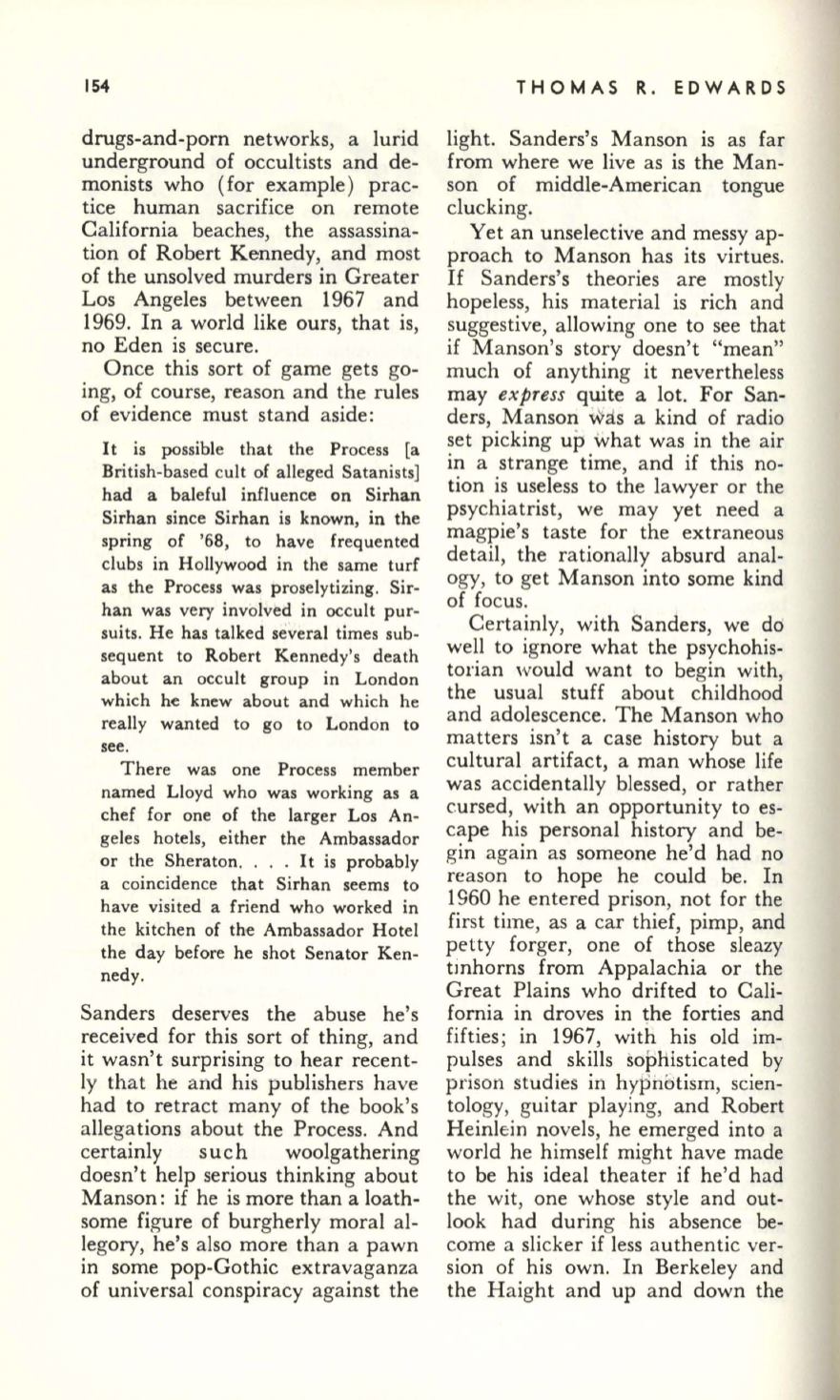
154
drugs-and-porn networks, a lurid
underground of occultists and de–
monists who (for example) prac–
tice human sacrifice on remote
California beaches, the assassina–
tion of Robert Kennedy, and most
of the unsolved murders in Greater
Los Angeles between 1967 and
1969. In a world like ours, that is,
no Eden is secure.
Once this sort of game gets go–
ing, of course, reason and the rules
of evidence must stand aside:
It is possible that the Process [a
British-based cult of alleged Satanists]
had a baleful influence on Sirhan
Sirhan since Sirhan is known, in the
spring of '68, to have frequented
clubs in Hollywood in the same turf
as the Process was proselytizing. Sir–
han was very involved in occult pur–
suits. He has talked several times sub–
sequent to Robert Kennedy's death
about an occult group in London
which he knew about and which he
really wanted to go to London to
see.
There was one Process member
named Lloyd who was working as a
chef for one of the larger Los An–
geles hotels, either the Ambassador
or the Sheraton....
It
is probably
a coincidence that Sirhan seems to
have visited a friend who worked in
the kitchen of the Ambassador Hotel
the day before he shot Senator Ken–
nedy.
Sanders deserves the abuse he's
received for this sort of thing, and
it wasn't surprising to hear recent–
ly that he and his publishers have
had to retract many of the book's
allegations about the Process. And
certainly
such woolgathering
doesn't help serious thinking about
Manson: if he is more than a loath–
some figure of burgherly moral al–
legory, he's also more than a pawn
in some pop-Gothic extravaganza
of universal conspiracy against the
THOMAS R. EDWARDS
light. Sanders's Manson is as far
from where we live as is the Man–
son of middle-American tongue
clucking.
Yet an unselective and messy ap–
proach to Manson has its virtues.
If
Sanders's theories are mostly
hopeless, his material is rich and
suggestive, allowing one to see that
if Manson's story doesn't "mean"
much of anything it nevertheless
may
express
quite a lot. For San–
ders, Manson
~as
a kind of radio
set picking up what was in the air
in a strange time, and if this no–
tion is useless to the lawyer or the
psychiatrist, we may yet need a
magpie's taste for the extraneous
detail, the rationally absurd anal–
ogy, to get Manson into some kind
of focus.
Certainly, with Sanders, we do
well to ignore what the psychohis–
torian would want to begin with,
the usual stuff about childhood
and adolescence. The Manson who
matters isn't a case history but a
cultural artifact, a man whose life
was accidentally blessed, or rather
cursed, with an opportunity to es–
cape his personal history and be–
gin again as someone he'd had no
reason to hope he could be. In
1960 he entered prison, not for the
first time, as a car thief, pimp, and
petty forger, one of those sleazy
tinhorns from Appalachia or the
Great Plains who drifted to Cali–
fornia in droves in the forties and
fifties ; in 1967, with his old im–
pulses and skills sopHisticated by
prison studies in hyphotism, scien–
tology, guitar playing, and Robert
Heinlein novels, he emerged into a
world he himself might have made
to be his ideal theater if he'd had
the wit, one whose style and out–
look had during his absence be–
come a slicker if less authentic ver–
sion of his own. In Berkeley and
the Haight and up and down the


